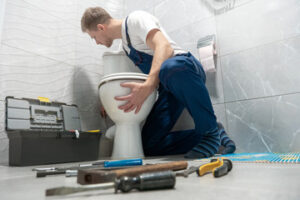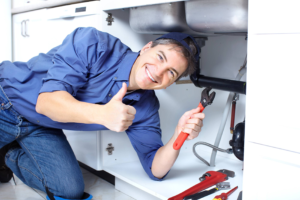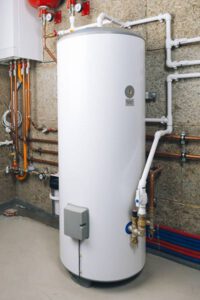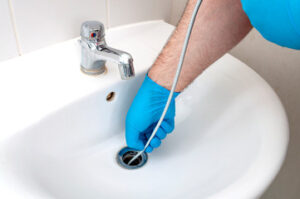The mold remediation process is disruptive and scary. It’s strangers in your house wearing “other-worldly” outfits and using serious chemicals.
The first thing Mold Remediation does is to identify and fix the moisture problem. Moisture offers mold spores the environment they need to grow and spread.
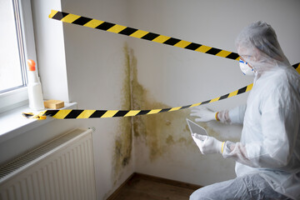
They then isolate the affected area with plastic sheeting and filtration devices. They spray the area with an EPA-approved biocide to kill mold spores.
The first step in a professional mold remediation is to clean the affected area. This process includes removing any materials contaminated with mold and disposing of them safely. This can include items like drywall, carpeting, fabric-covered furniture, and more. This step also involves sanitizing and deodorizing the areas where mold has been removed.
The next step in the process is to dry all of the cleaned materials. This helps ensure that all of the moisture is gone and that no mold spores remain. Experts often use fans and dehumidifiers to speed up this process. This is especially important for porous materials that can’t be dried with air conditioning, such as drywall or carpeting.
After the area is thoroughly sanitized and dried, the next step is to rebuild and replace any materials that were removed during the process. This may include drywall, insulation, and carpeting. This can be especially helpful for homes that are being sold. Homebuyers typically want to see that any issues with mold have been addressed before completing the purchase.
Lastly, experts recommend that homeowners seal and repaint any surfaces where mold was removed. This helps protect the surface from future mold growth and makes it easier to clean in the future.
For small spots of mold, you can try cleaning the area with bleach and water. Apply the solution to the affected area with a sponge or cleaning brush and scrub. Make sure you wear rubber gloves when handling any cleaners and let the surface dry.
For larger areas of mold, a professional mold remediation company will spray the affected area with biocide. This is an EPA-approved liquid that kills the mold spores and renders them sterile. This step is followed by a thorough clean of the affected area with HEPA-approved vacuums and damp wiping. Finally, the affected area is painted with whitewash or another protective coating.
While mildew can be scrubbed away with a cleaning brush and store-bought mold killer, most molds require special chemicals or professional remediation. The first step in mold remediation is to find and fix the source of the problem. The next is to clean the affected area and then reseal it with whitewash or other mold inhibitors. Finally, the structure should be dried out using fans and dehumidifiers to prevent re-growth.
Molds grow when they are exposed to moisture, food and poor air circulation. These factors are often present in rooms such as basements, attics and bathrooms. To kill the fungi, biocide (an EPA-approved liquid that sterilizes the mold) is sprayed onto affected areas of a home or building. This liquid is then allowed to dry and the mold spores are rendered inert.
During the cleaning phase, workers wear protective clothing and dust masks to protect themselves from inhaling spores and mold residues. They use HEPA-approved vacuums to remove any remaining residue and spores from the microbial spray used during the remediation process. They also damp-wipe and dry all surfaces to prepare them for resealing with whitewash or other mold inhibitors.
It’s important to note that the cleaning of mold is a temporary solution, and once the fungi have been eliminated, they will begin growing again in the same spot, so it’s critical to correct the source of the problem and address any water or humidity issues. The most effective way to prevent the recurrence of a mold infestation is to address the root cause of the problem, such as a leak in the roof or a vent that’s not allowing sufficient ventilation.
Some home owners use natural methods to clean mold, such as white vinegar. This is an inexpensive option that can be used on surfaces such as drywall, carpets, tile and countertops. You will need to scrub the surface, let it sit for 30 minutes at least and then scrubbing again before rinsing the area with clean, warm water. Another natural method is to mix baking soda with water and vinegar to create a paste. Apply the paste to the affected surface and allow it to sit for at least 30 minutes, scrubbing again before rinsing.
Molds produce spores that float through the air and can cause allergies, asthma, infections, and other health problems. Infants and children, the elderly, and people with weakened immune systems are especially susceptible to the effects of mold.
One of the primary responses to a mold problem is to isolate the area that is contaminated and protect occupants of the building while the contaminant is cleaned and removed. This is accomplished by sealing the contaminated area with plastic sheeting and preventing the spread of mold spores to other areas. This should be done before attempting any repair or reconstruction work. It is also important to address the underlying water or moisture issue, as the mold problem will return if the source of the moisture is not corrected.
The level of containment required should be based on the amount of contamination and the potential for remediator or occupant exposure. In general, full containment is recommended for areas involving extensive mold growth and a high level of toxicity, while limited containment is recommended for areas containing moderate to light levels of mold. It is generally not necessary to sterilize the contaminated area, as a background level of mold spores similar to that in the ambient air will persist.
During isolation, occupants should wear protective gear such as masks or respirators, gloves, long sleeves, and pants to avoid direct contact with the moldy materials. They should not attempt to open and repair any contaminated surfaces, as this could result in the spreading of mold spores throughout the structure. It is also advisable to have a full-service restoration company remove and replace any contaminated materials that are beyond salvageable.
During the isolation process, it is also important to note that many fungi have highly specific nutrient requirements and are specialized to use particular materials, for example, some fungi can grow on creosote, while others cannot. Fungologists can often isolate these fungi by “baiting” them with the nutrient they require. For example, by coating matchsticks with creosote, some fungi such as Amorphotheca resiniae can be isolated from the surrounding soil.
Mold spores are everywhere in our environment, and they are naturally occurring. What makes them a nuisance is when they are consistently present in damp conditions where there is an organic food source such as wood, paper, carpeting or fabric. Mold remediation services can be used to eliminate the spores and clean surfaces that have been contaminated by them. They can also be used to treat an entire home or business with antimicrobial chemicals that prevent mold growth and reduce spore levels in the air.
The first step in the remediation process is to identify the cause of the mold. This could be a leak, condensation, lack of ventilation or plumbing problems. It is important to fix the problem so that the mold does not return after the remediation has been completed.
Once the cause of the mold has been addressed, the professionals will seal the area to prevent the spread of mold spores to unaffected areas. This can be done by putting plastic sheeting over windows and other openings. This will also keep dust particles containing mold spores from blowing through the house while the work is being performed.
Next, the professional mold remediation company will scrub and clean all surfaces contaminated by the mold. This may include the use of disinfectant, bleach or an EPA-approved biocide. The surfaces are then dried with dehumidifiers and fans, and any soft or porous items that were contaminated by the mold are discarded. This includes things like drywall, carpeting and curtains.
After the cleaning and drying have been completed, the professional mold remediation company will apply an EPA-approved biocide to the remaining surfaces. This will kill the mold spores and prevent them from growing again, as long as the surfaces remain dry.
If the mold is particularly hazardous, then a specialized disposal service may be required to transport and dispose of the materials. The remaining clean and uncontaminated surfaces can then be reconstructed with new materials. The final step is to retest the air and surfaces to ensure that they are clear of all toxic mold spores and have returned to normal fungal ecology.
